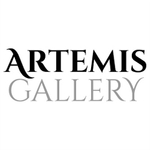Lovely Romano-Egyptian Sarcophagus Mask of Woman
Lot 24
About Seller
Artemis Fine Arts
686 S Taylor Ave, Ste 106
Louisville, CO 80027
United States
Selling antiquities, ancient and ethnographic art online since 1993, Artemis Gallery specializes in Classical Antiquities (Egyptian, Greek, Roman, Near Eastern), Asian, Pre-Columbian, African / Tribal / Oceanographic art. Our extensive inventory includes pottery, stone, metal, wood, glass and textil...Read more
Estimate:
$12,000 - $18,000
Starting Bid
$6,500
Absentee vs Live bid
Two ways to bid:
- Leave a max absentee bid and the platform will bid on your behalf up to your maximum bid during the live auction.
- Bid live during the auction and your bids will be submitted real-time to the auctioneer.
Bid Increments
| Price | Bid Increment |
|---|---|
| $0 | $25 |
| $300 | $50 |
| $1,000 | $100 |
| $2,000 | $250 |
| $5,000 | $500 |
| $10,000 | $1,000 |
| $20,000 | $2,500 |
| $50,000 | $5,000 |
| $100,000 | $10,000 |
| $200,000 | $20,000 |
About Auction
By Artemis Fine Arts
Mar 20, 2025
Set Reminder
2025-03-20 10:00:00
2025-03-20 10:00:00
America/New_York
Bidsquare
Bidsquare : Exceptional Finds | Ancient, Ethno, Fine Art
https://www.bidsquare.com/auctions/artemis-gallery/exceptional-finds-ancient-ethno-fine-art-18151
Explore a world of classical antiquities and ethnographic masterpieces, with treasures from every corner of the globe. Discover Egyptian relics, Greek and Roman artifacts, Etruscan elegance, Near Eastern wonders, and Asian heritage. Marvel at Pre-Columbian marvels, Native American artistry, African tribal expressions, and Oceanic cultural gems. Spanish Colonial legacies, Russian craftsmanship, and a spectrum of fine and visual arts await, offering a captivating journey through history and artistry, connecting cultures across time. Artemis Fine Arts info@artemisgallery.com
Explore a world of classical antiquities and ethnographic masterpieces, with treasures from every corner of the globe. Discover Egyptian relics, Greek and Roman artifacts, Etruscan elegance, Near Eastern wonders, and Asian heritage. Marvel at Pre-Columbian marvels, Native American artistry, African tribal expressions, and Oceanic cultural gems. Spanish Colonial legacies, Russian craftsmanship, and a spectrum of fine and visual arts await, offering a captivating journey through history and artistry, connecting cultures across time. Artemis Fine Arts info@artemisgallery.com
- Lot Description
Ancient Egypt, Romano-Egyptian period, ca. 30 BCE to 300 CE. A sarcophagus mask of a woman's face, made from layers of plaster or stucco upon papyrus or linen, and painted with bold features in black and white. The dramatic eyes are outlined with stark black pupils to mimic kohl cosmetic eyeliner and her fashionable coiffure is arranged into incised rows and covered in applied black pigment, and traces of the original mask backing feature thin black stripes with areas of turquoise and pink-hued pigment on one side. A mask like this would have been placed over the face and fastened into the linen wrappings of a mummy. Death masks were created for the soul to recognize the body and return to it, and so masks were made in the relative likeness of the deceased. Such portrait masks are significant, because they demonstrate conclusively that Greco-Roman individuals represented in encaustic paintings also subscribed to traditional Egyptian beliefs about the afterlife. Size: 7.5" L x 6.25" W (19 cm x 15.9 cm); 9.75" H (24.8 cm) on included custom stand.
A shift towards more naturalistic features, as seen here, reflects the profound change that the Greco-Roman world brought to Egypt. Depictions of a deceased person's distinctive face, full head, or body replaced the stylized art of dynastic Egypt. Masks like this one would have served to honor the dead and, as such, were typically displayed next to a simple wooden coffin during funeral rites and then buried with the dead. Some scholars posit that Egyptians began to follow traditional Roman mortuary practices during the Romano-Egyptian period as well. In such traditions, these masks would be worn by a family member or actor during the funeral procession then displayed within an aristocratic household throughout the year and worn annually during Parentalia (a 9-day Roman festival in honor of family ancestors).
Provenance: ex-Apollo Art Auctions, London, UK; ex-property of a London gallery, acquired on the US art market; ex-New York City, New York, USA collection; ex-F.F. collection, New York City, New York, USA; ex-Barakat Gallery, Beverly Hills, California, USA; ex-private collection, acquired on the London art market in the 1980s; ex-Shlomo Moussaieff collection, London, England, acquired in 1969
All items legal to buy/sell under U.S. Statute covering cultural patrimony Code 2600, CHAPTER 14, and are guaranteed to be as described or your money back.
A Certificate of Authenticity will accompany all winning bids.
We ship worldwide and handle all shipping in-house for your convenience.
SHIPPING EXCEPTIONS: Due to customs clearance issues, we are unable to ship to Germany, Switzerland and Australia. If you live in Germany, Switzerland or Australia, you will need to provide an alternate shipping destination, or we will not be able to complete your purchase. In addition, please note that we are unable to ship ancient items back to the original country of origin (Egyptian to Egypt, Greek to Greece, etc.)
PAYMENT EXCEPTION: Unless a known customer of Artemis, payment for all gold / precious metal / gem lots must be made via Bank Wire Transfer or Certified Bank Check/Money Order, no exceptions."
#191852Repainted, with touchups to eyes, and coiffure. Restored and repaired from multiple pieces, with some areas of restoration visible along hollow interior, and resurfacing and overpainting along break lines and new material. Losses to areas of cheeks, neckline, coiffure, and mask peripheries as shown. Fading to original pigmentation, with minor nicks to nose, forehead, coiffure, and peripheries, and light encrustations. Nice earthen deposits and great traces of original pigment throughout. Modern adhesive strips on verso for stabilization.Condition
- Shipping Info
-
All shipping is handled in-house for your convenience. Your invoice from Artemis Gallery will include shipping calculation instructions. If in doubt, please inquire BEFORE bidding for estimated shipping costs for individual items.
-
- Buyer's Premium



 EUR
EUR CAD
CAD AUD
AUD GBP
GBP MXN
MXN HKD
HKD CNY
CNY MYR
MYR SEK
SEK SGD
SGD CHF
CHF THB
THB














